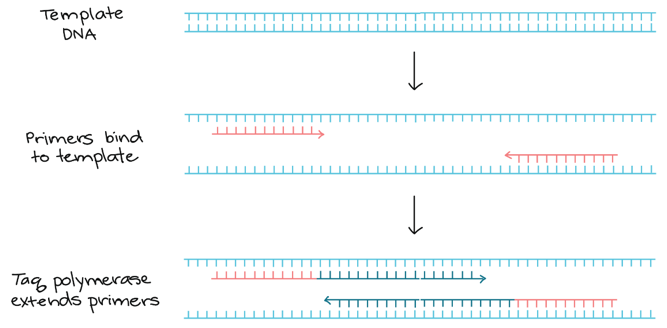Padmanabha D, Padilla PA, You Y, Baker KD (2015)
A HIF-Independent Mediator of Transcriptional Responses to Oxygen
by Deprivation in Caenorhabditis Elegans
Genetics, Vol. 199, 739-748
A HIF-Independent Mediator of Transcriptional Responses to Oxygen
by Deprivation in Caenorhabditis Elegans
Genetics, Vol. 199, 739-748
(Translated by Emaan Chaudry)
qPCR
Throughout this paper, qPCR is used in order to obtain many results discussed. The polymerase chain reaction (PCR) is a lab technique used to amplify and detect DNA and RNA sequences. So how does PCR work? In order to start the PCR, primers need to be used to cut out the short strand of DNA or RNA of interest. PCR primers are short strands of artificial DNA that work by being a complementary pair to the DNA strand of interest. When the primers bind, it enables Taq polymerase to bind. This is a specific type of DNA polymerase that is stable at high temperatures. This polymerase allows for the rest of the sequence to be synthesized (see figure 1) [1].
| 
Figure 1: An illustration of primers binding to the template strand and Taq polymerase functioning [1].
|
|
Once the double stranded DNA is isolated, the three steps of PCR are denaturation, annealing and extension. During denaturation, the double stranded DNA separates into two single strands. This is done by heating the reaction to about 96 degrees Celsius. The next step, annealing, cools the reaction to a temperature between 55 and 65 degrees Celsius. This allows for the primers to be added to the complementary sequences of the single stranded DNA. The last step, extension, is done at a temperature of 72 degrees Celsius. This allows for Taq polymerase to extend the primers and synthesize the new strands of DNA. This process is repeated numerous times in order to amplify the amount of the sequence [1]. A summary of these steps can be seen in figure 2.
|

Figure 2: An illustration of the polymerase chain reaction (PCR) [2].
|
References1. Polymerase chain reaction (PCR). (n.d.). Retrieved from https://www.khanacademy.org/science/biology/biotech-dna-technology/dna-sequencing-pcr-electrophoresis/a/polymerase-chain-reaction-pcr 2. What is PCR (polymerase chain reaction)? (2016, January 25). Retrieved from https://www.yourgenome.org/facts/what-is-pcr-polymerase-chain-reaction |